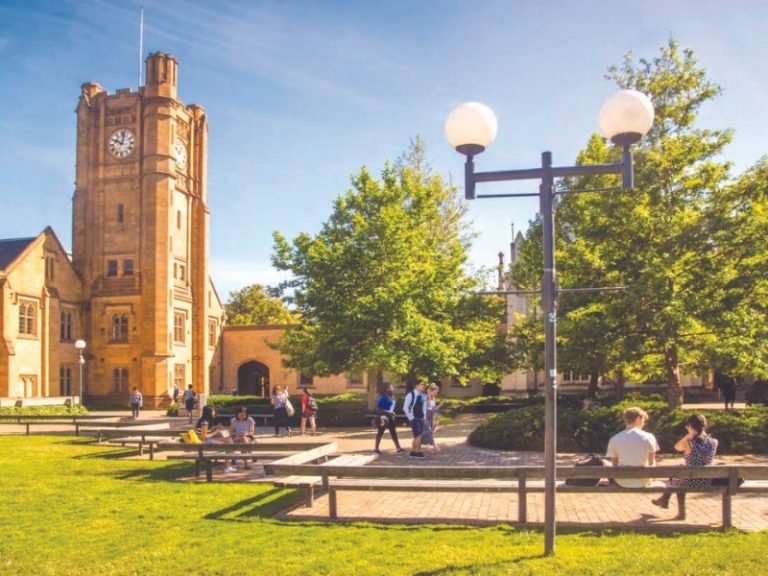University of Melbourne, Australia
UoM (estb. 1853) has nurtured four Australian prime ministers, five governors general and eight Nobel laureates. Times Higher Education ranks it Australia #1 and #33 worldwide, writes Reshma Ravishanker

Melbourne University
The sixth continent’s second-oldest public higher education institution, University of Melbourne (UoM, estb.1853) has nurtured four Australian prime ministers, five governors-general and eight Nobel laureates — the most of any university Down Under. The London-based Times Higher Education ranks UoM Australia’s #1 university and #33 worldwide in its World University Rankings 2022. The China-based Shanghai Jiao Tong University Institute of Higher Education ranks UoM among the world’s Top 35 universities in its Academic Ranking of World Universities 2022.
Legislated by a special Act of the Parliament of Victoria in 1853, UoM admitted its first batch of 16 students and four professors in a cluster of buildings on the fringes of Melbourne. During the 1900s, UoM expanded significantly when the university amalgamated a number of undergrad colleges, and initiated a curriculum makeover in 2008. Under the new UoM model, students are encouraged to sign up for a general bachelor’s degree before undertaking specialised postgraduate and professional courses.
Sited on six leafy campuses in the state of Victoria, UoM’s ten faculties offer bachelors, Masters and doctoral programmes to 52,000 students from 150 countries. The university boasts a substantial endowment of $1.33 billion (Rs.10,357 crore)
Melbourne. The capital of the south-eastern state of Victoria and the continent’s second-most populous city, Melbourne (pop.5.31 million) has been adjudged the world’s #1 urban habitat for seven consecutive years (2011-2017) in the Economist Intelligence Unit’s Global Liveability Index. A prominent financial hub of the Asia-Pacific region, this well-kempt metropolis offers a smooth public transport system and numerous shopping options.
For those interested in the arts, Melbourne provides world-class theatre, concerts and galleries. And true to the tradition of sports-crazy Australia, UoM offers sports lovers opportunities to witness world-class events such as the Australian Grand Prix and Australian Open. Other attractions include the Melbourne Cricket Ground, National Gallery of Victoria, the World Heritage-listed Royal Exhibition Building, Queen Victoria Market, Royal Botanical Gardens, Puffing Billy Railways, and the Melbourne Zoo. Within an hour’s drive of Melbourne are some of Oz’s most unspoilt beaches, rainforest, mountains and lakes.
Mean temperatures average is 60C in winter and 310C in summer.
Campus facilities. The university’s main Parkville campus hosts a mix of historic buildings and awards-winning modern architecture. Within walking distance of downtown Melbourne, the campus hosts ten faculties, state-of-the-art laboratories, IT-enabled classrooms, 12 libraries, specialty stores, cafes, gyms, a supermarket, and a seasonal farmers market. Sports facilities are extensive and include an athletics track, olympic size swimming pool, a cricket oval, tennis and squash courts, and fitness centres.
UoM’s six other specialist campuses — Southbank, Burnley, Creswick, Dookie, Shepparton and Werribee —are spread across Victoria state. The Southbank Campus housed within the Melbourne Conservatorium of Music offers contemporary music studios and galleries. Established by the Victorian Department of Agriculture, a short ride from central Melbourne is the Burnley Campus which offers courses in urban, environmental and ornamental horticulture. The Dookie campus hosts a functional farm, modern robotic dairy, orchard, winery and natural bush reserve and the Creswick campus is Australia’s sole dedicated forest science and research centre. To the South-west is the Werribee Campus with excellent veterinary education facilities, and Shepparton hosts the Academy of Sport Health and Education (ASHE) and the Department of Rural Health.
Moreover, students can sign up for activities offered by over 200 clubs and societies.
Admission. The minimum admission qualifications for admission into UoM’s undergraduate programmes are successful completion of class XII and English language proficiency (IELTS, TOEFL, and Pearson PTE Academic test scores). Admission criteria for specialised study programmes are listed on https://study.unimelb.edu.au/.
For admission into postgraduate programmes, eligibility criteria are completion of a bachelor’s degree programme and English language proficiency. For further information, visit https://study.unimelb.edu.au/how-to-apply/graduate-coursework-study.
Accommodation. Students can choose from a range of university housing options including Lisa Bellear House, Little Hall, The Lofts, university apartments and UniLodge Lincoln House. All options offer studio apartments with shared kitchens, laundry facilities and wi-fi access, among other facilities. For instance, the Lisa Bellear House comprises 285 rooms, ranging from self-contained studios to private rooms in a shared apartment, with common gymnasium, music room, basketball court, study spaces and community kitchen.
Degree programmes. The university’s ten faculties/schools offer a wide range of undergraduate, postgraduate, and research programmes.
Scholastic Options AT UoM
University of Melbourne offers a wide range of undergraduate and postgrad programmes across ten faculties. They include:
Architecture, Building and Planning. Melbourne School of Design
Faculty of Arts. Arabic studies, anthropology, arts history, art education, Asian studies, Chinese studies, Chinese societies, creative writing, dance, English and theatre studies, musicology, Korean studies
Business and Economics. Melbourne Business School, Melbourne School of Professional and Continuing Education
Education. Melbourne Graduate School of Education
Engineering. Computing, computer software systems, mathematics and science, mathematics and statistics, mechatronics engineering systems
Fine Arts and Music. Victorian College of the Arts and Melbourne Conservatorium of Music
Law. Melbourne Law School and Melbourne School of Government
Medicine, Dentistry and Health Sciences. Faculty of medicine, dentistry and health sciences, Melbourne Dental School, Melbourne Medical School, Melbourne School of Health Sciences, Melbourne School of Population and Global Health, Melbourne School of Psychological Sciences and School of Biomedical Sciences
Science. Biosciences, chemistry, ecosystem and forest sciences, geography, earth and atmospheric sciences, mathematics and statistics, physics
Veterinary and Agricultural Sciences. Veterinary, agricultural and food science
Tuition fees (per year): A$31,260
Living expenses: A$30,500 NB A$=Rs.55
Also Read: Australian National University, Canberra

















Add comment